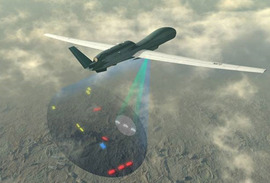In last week’s article on the use of drones in Yemen, I discussed how the use of drones as a counterterrorism strategy will not help the United States defeat Al Qaeda in the Arabian Peninsula (AQAP). Not only is the use of drones increasing the salience of anti-Western and anti-Yemeni government propaganda, it also allows AQAP to maintain a wide pool of recruits, and fails to address the issues within Yemen that are allowing AQAP to use it as a safe haven.
The other shortcomings of the use of drones in Yemen centre around the targeted drone strikes and their intended targets. Throughout much of the War on Terror, the use of drones has centred on the need to eliminate “high-value targets”. These targets are those figures the US perceives to be the authorities in Al Qaeda able to pose a significant threat to international security. This approach has been combined with Special Ops raids and other military counterterrorism tactics that turned out to be useful in decimating Al Qaeda’s core in Afghanistan and Pakistan.
Nonetheless, one thing that the US has started to realize is that not all lessons are transferable. As Yemen expert Gregory Johnsen stated, part of the problem with the use of drones by the US is that they tend to focus on targeting personalities and targets of “operational significance” rather than the terrorist network as a whole. AQAP, however, has proven to be far more adaptable and resilient than Al Qaeda Central. Unlike AQC, AQAP is reliant on a few notable members for its survival, and even with the loss of some high profile members, AQAP continues to evolve and pose a threat to the US and other NATO member countries.
Johnsen refers to the tactic of making high profile individuals the target of drone and intelligence efforts as “mowing the lawn of terror, but not attacking the root”. Furthermore, he argues that focusing purely on certain personalities or big names within AQAP only succeeds in allowing America to scratch names off the “Most Wanted” list. Although this can be a useful tool for retaining domestic support for drone strikes in Yemen, in the long run it does little to eliminate AQAP.
This is not to say there haven’t been notable successes in Yemen. A targeted drone strike in September 2011 resulted in the death of Anwar al–Awlaki, a Yemeni-American citizen believed to be the head of AQAP’s external operations unit, and one of the main individuals behind AQAP’s English publicity. Furthermore, this year, deputy commander of AQAP, Said al-Shihri, was also killed by a targeted drone.
The problem is, however, that successes such as the one that led to the death of Awlaki do not occur frequently, because when it comes to AQAP in Yemen, US intelligence is often extremely weak and unreliable. In fact, according to Salon, earlier this month the White House was unable to tell whether a Yemeni killed in a recent strike was or was not AQAP’s bomb maker, Ibrahim al-Asiri, who it turned out not to be. As Johnsen states, “The US doesn’t seem to have good human intelligence [in Yemen]. It’s essentially bombing and hoping, which is neither sustainable nor wise.”
Focusing solely on “high-profile targets” and ignoring the broader terrorist network causes the US and its intelligence officials to function with tunnel vision when using drones, which in the past has had adverse consequences. As Johnsen explains, when Nasir al-Wuhayshi and Qasim al-Raymi, two of AQAPs most dangerous members, escaped from prison in 2006 in Sana’a, the US paid little attention to recapturing them and prioritized what the US considered at the time to be high profile terrorists. This, in turn, allowed Wuyhayshi and Raymi to resurrect Al Qaeda in Yemen, and transform it into the AQAP that exists today.
The Obama Administration has increased the number of drone strikes and expanded its pool of targets. This comes despite the fact that Obama has pledged to limit the drone program. It remains to be seen if expanding the pool of targets can take place while limiting the used of drones strikes. At the moment the US are using an old counterterrorism tactic on a new and improved Al Qaeda. It isn’t going to get the US closer to any victory soon in Yemen.




